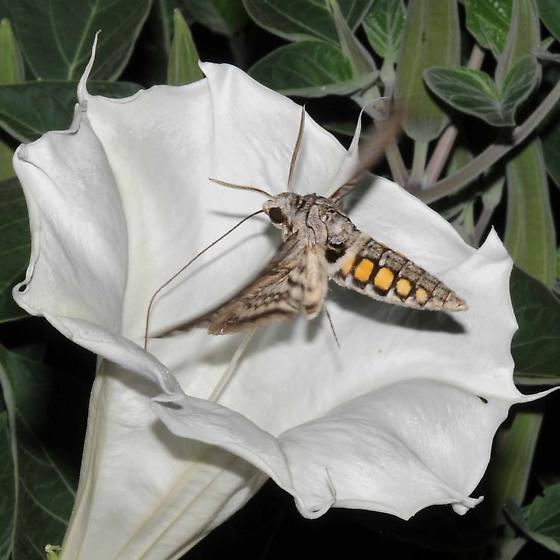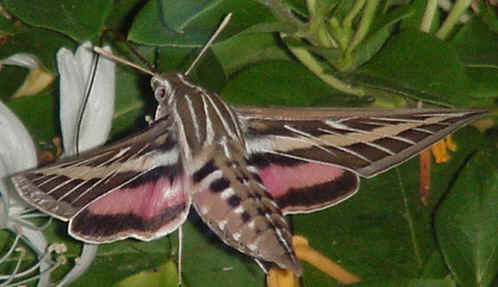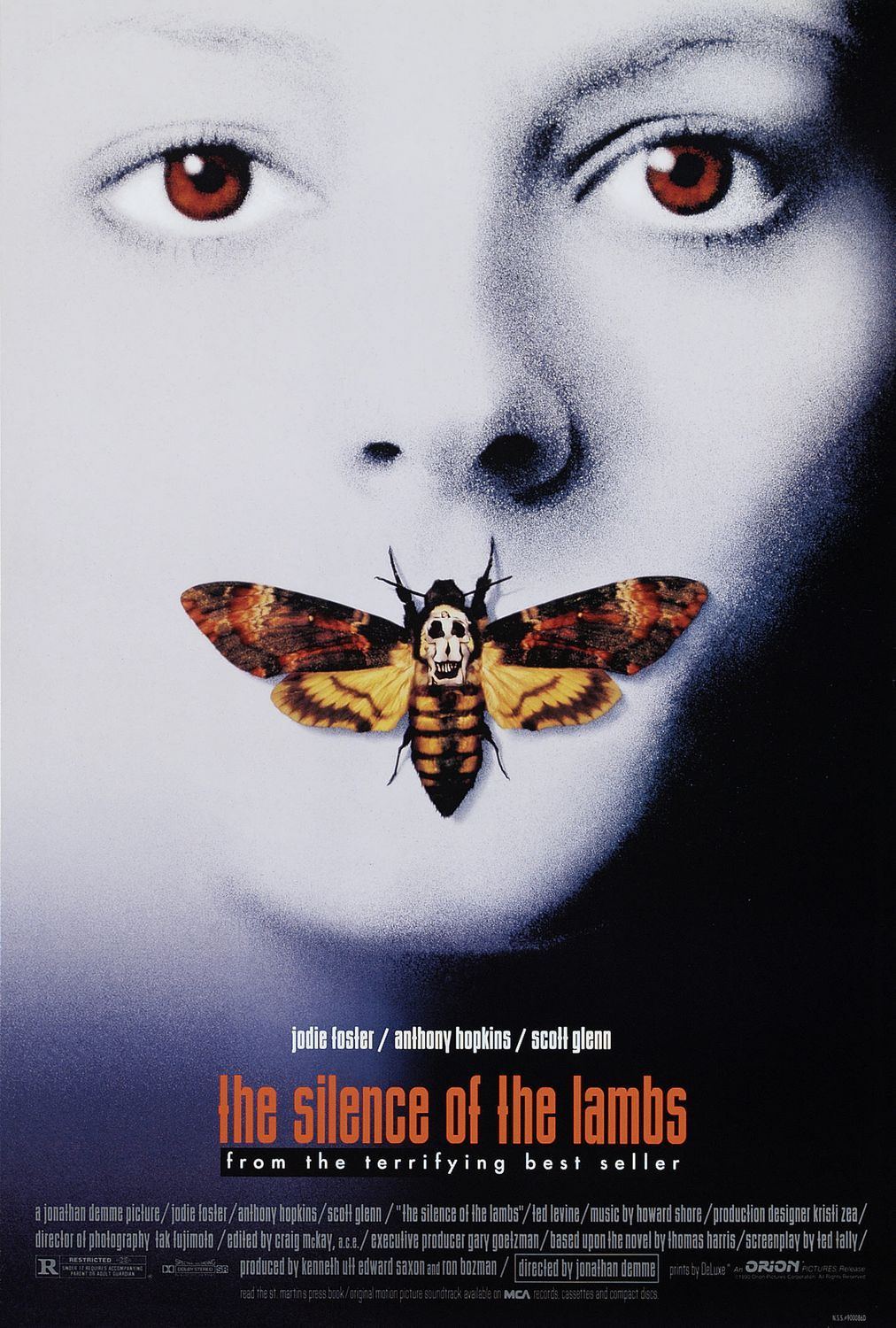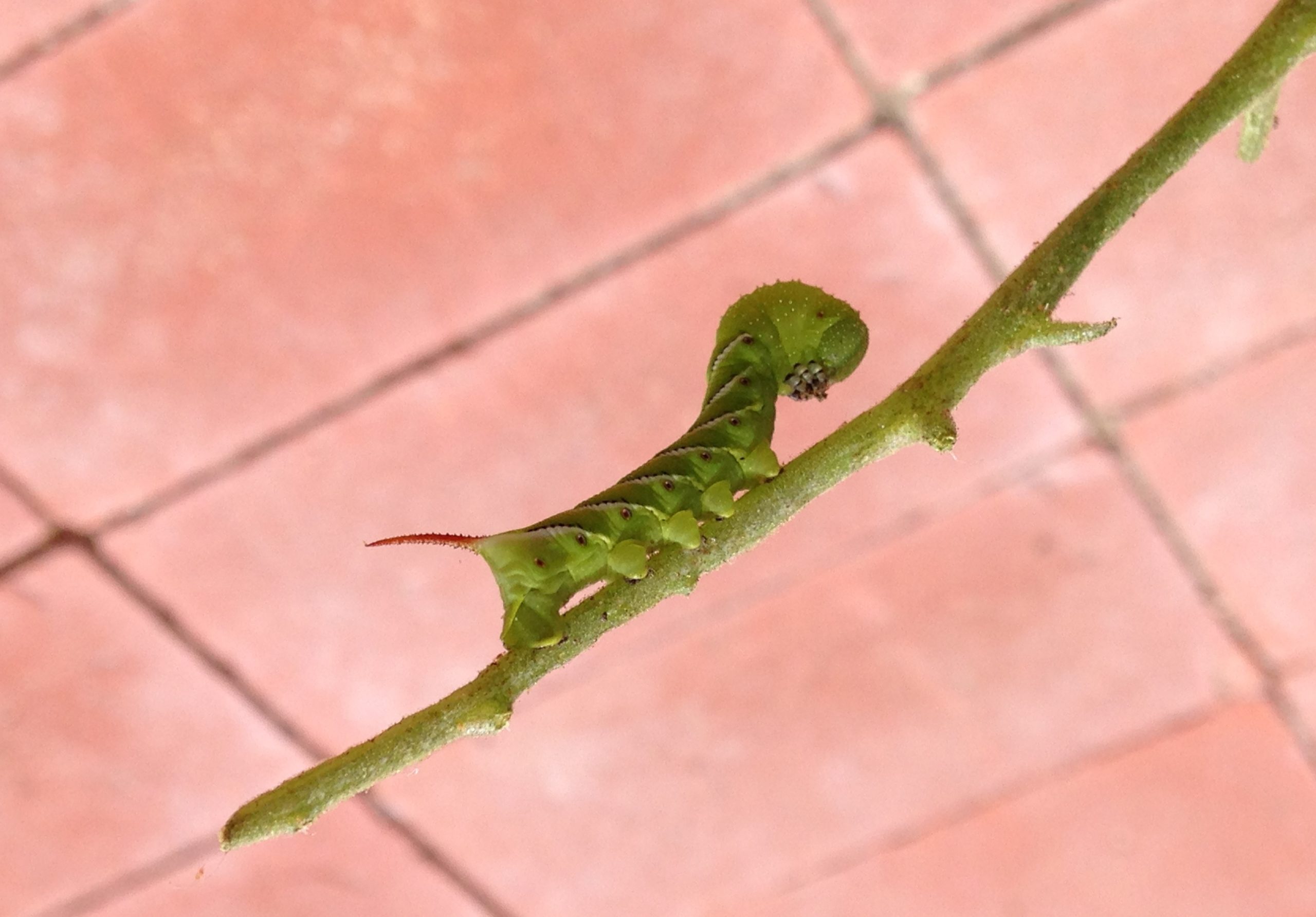Vegetable gardeners might be inclined to squish tomato and tobacco hornworms, which feast voraciously on tomato, pepper and potato plants and other members of the Solanaceae family this time of year. But hey, it’s Pollinator Week, so consider ceding a few fruits or entire plants to these dramatic caterpillars, which later morph into beautiful Sphinx Moths.
Loathed by gardeners in its caterpillar stage, the Manduca quinquemaculata, or tomato hornworm, has eight V-shaped marks on each side and a signature horn on the rear. Manduca sexta, the tobacco hornworm, closely resembles its tomato preferring cousin, but shows seven diagonal white lines on its sides and a curved horn.
Both caterpillars turn into large moths with four- to six-inch wingspans in colors ranging from brown and gold to pink and grey. They often are mistaken for small hummingbirds when they fly during the day and hover helicopter style to nectar on flowers, which is why they are also called Hummingbird or Hawk Moths.

Sphinx Moth on Datura, a.k.a. Jimsonweed, photo by Betsy Betros, via BugGuide.net
Both caterpillars turn into large moths with four- to six-inch wingspans in colors ranging from brown and gold to pink and grey. They often are mistaken for small hummingbirds when they fly during the day and hover helicopter style to nectar on flowers, which is why they are also called Hummingbird or Hawk Moths.
Moths, the nocturnal brethren of butterflies, are generally under appreciated and yet many are as striking as their celebrated butterfly siblings. Like butterflies, moths perform necessary pollination tasks and serve as primary fodder for bats, birds, even small mammals.

C’mon, admit it: she’s adorable. Sphinx Moth, photo courtesy Colorado State University extension office

Perfectly disguised: the intriguing Sphinx Moth caterpillar blends in on this Datura, a.k.a. Jimsonweed plant.
The hornworm caterpillars get their name from the signature horns that grace their hind ends. The “Sphinx Moth” monicker results from the distinct pose the caterpillar assumes when disturbed. Upon the mildest poke, the creature rears its head in a thoughtful stance, hoisting the upper third of its body in a sphinx-like posture.
The 1991 thriller The Silence of the Lambs, starring Jodi Foster as tenacious cop Clarice Starling and Anthony Hopkins as cannibalistic serial killer, Hannibal Lecter, didn’t help moths’ reputation. In the award-winning movie, “Hannibal the Cannibal” places the cocoon of a certain species of hawk moth, the Death’s Head Hawk Moth, in the mouths of his victims as some sort of sick gesture of transformation. The moths fly around in a creepy, dark basement and evoke a weird terror.
According to the film trivia website IMDb, the tobacco hornworm moths used in the the film were treated like celebrities by the filmmakers: “They were flown first class to the set (in a special carrier), and had special living quarters (rooms with controlled humidity and heat).”
The movie poster at right featured Jodi Foster with a tobacco hornworm moth photoshopped with a skeleton skull–actually a realistic portrayal of the Death’s Head Hawk Moth, which is generally only found in Africa and southern Europe.
Interestingly, the iconic Death’s Head Hawk Moth tapped for the film is one of few moths that makes a squeaking sound when startled. Described as a loud, high-pitched squeak, the noise results from air expelling from their proboscis–which might have come in handy during encounters with Hannibal the Cannibal.

The thriller, Silence of the Lambs, contributed to moths’ creepy rep.
Related posts:
- Interview With the Sphinx Moth, Spokesmoth for National Moth Week
- Join us for Malt, Hops and Moths: Moth Night at the Alamo Brewery July 23
- Four Fine Texas Moths for National Moth Week
- Large, Batlike and Harmless: Black Witch Moth Making Appearances in South Texas
- Happy Pollinator Week! Unpaid Workers of Food Web Deserve Respect and Resources
- Genista Moth Caterpillars Return to Llano River Mountain Laurels
- IH 35 to Become Pollinator Corridor for Bees, Monarch Butterflies, Other Pollinators
- Endangered Species Act: Wrong tool for the Job of Monarch butterfly Conservation?
- Tropical milkweed: Ok for Monarch Butterflies, “Just Cut the Dang Stuff Down”
- Wildly Successful: Pollinator Powwow Draws Hundreds from Texas and Beyond
Like what you’re reading? Follow butterfly and native plant news at the Texas Butterfly Ranch. Sign up for email delivery in the righthand navigation bar of this page, like us on Facebook, or follow us on Twitter, @monikam. You can also read our stuff on the Rivard Report.


One of the more intriguing aspects of SILENCE OF THE LAMBS was the scene with the etymologists at New York’s Museum of Natural History. Clever business with the death’s head moth. Thanks for the movie – tobacco hornworm connection. Ken
Did you know gardeners can live in harmony with tomato/tobacco hornworms? Plant a sacrificial tomato plant away from your main crop. Keep the blossoms plucked off and feed with lots of nitrogen fertilizer to grow lots of leaves. Pluck off the caterpillars from your plants you want fruit on and put on the sacrificial one!
My friends who have chickens say tomato hornworms are a favorite treat. Nature is cruel.
Thanks for posting this Betsy. We have the “donor” tomato plant this year. I’ve trudged up the hill many a time to give the chubby worms a chance at flying. I just happened to see one last night on the zinnias! Hope others will join.
They also love morning glories. I grow a huge patch and rarely even find them on my tomatoes. If I do I just relocate them.
Thanks Betsy! We’re in AZ and I found one on our pepper plant, happily munching away. I haven’t the heart to kill him so will leave him alone. We need more butterflies and bees!
Awesome
Yes! I have done this! Thank you for supporting this lovely creature,!
I just stumbled across your blog when I was trying to identify the difference between a Queen and Monarch butterfly. What a great blog! Wish I had found you earlier. I’m trying to create a butterfly, bird and bee habitat in my backyard. I’m doing my part to help the Monarch population. I have Milkweed, passion flower vines and parsley. Any must have plants to attract butterflies?
PS I noticed a Zebra longwing butterfly twice this summer in my backyard. I’m thinking this is unusual for San Antonio. Maybe climate change is to blame?
Thanks, Stephanie. You definitely want some lantana and pentas. Also, I love Jimsonweed for Sphinx moths. There’s so many possibilities!
Yes, climate change is bringing some unusual visitors. Zebra longings are not unheard of here, but they’re not uncommon. I used to get them occasionally in Alamo Heights. Good luck!
MM
Four O’Clocks are a favorite too – and they reseed every year – hardy annuals – come in all sorts of colors – bright pinks, yellows, whites — no purple or blues though –
Can anyone make a comment of the type of butterfly that has furry protrutions from the wings, maybe black butterflies.
[…] have seen large moths like the adult form of the tomato hornworm on our porch before, so maybe this has been present all along and we never […]
The passion flowers have a unique structure, which in most cases requires a large bee to effectively pollinate. In the American tropics, wooden beams are mounted very near passionfruit plantings to encourage carpenter bees to nest. The size and structure of flowers of other Passiflora species is optimized for pollination by hummingbirds (especially hermits like Phaethornis), bumble bees, wasps or bats, while yet others are self-pollinating..^,:
” In the award-winning movie, “Hannibal the Cannibal” places the cocoon of a certain species of hawk moth, the Death’s Head Hawk Moth, in the mouths of his victims as some sort of sick gesture of transformation.”
It wasn’t Hannibal who did this, it was Buffalo Bill. It symbolized his transformation from man to woman. Get your facts right!
actually, the movie is “Silence of the Lambs”…
I was just wondering how this green horned worm changes into a moth does go underground or make a cocoon
They go underground.
I just found a Tomato Hornworm in my yard. Yesterday it was crawling around and today it looked like it was darkening in color and not nearly the energy it had the day before. I would like to try and save it so it can become this beautiful moth. Any suggestions?
I found 3 Tomato Horn-worms in my garden and I got them and put them in a big container.Each day I got them some of my leaves from my tomato plant .Today they made a cocoon and I’m waiting for them to hatch. I’m 9 years old and have been collecting bugs for most of my life.
Wow Aiden, what a great idea. I’m going to try that if I find some this year. I bet it’s wonderful to watch them transform. Thank you for sharing.
did you know that these catipillers are a good source of protien (but only if you are starveing
Mm-mm, boy howdy – them’s good eatin’!
Great article! Myself and my niece found a horntail caterpillar I’m our yard not too far from our tomato plants. We placed him in a large bowl with some grass, tomato leaves, a capful of water (my nieces idea lol) and a nice stick to crawl up so he can cocoon when he’s ready
Interestingly, the “skull” on the moth on the Silence of the Lambs poster, is not a skull at all but a portrait of seven nude women called “In Voluptas Mors” collaborated by Salvador Dali & Philippe Halsman. Zoom in the poster or google the name of the portrait.
Aside from that, I’ll have to reconsider killing the horntails on my tomatoes, now that I know what beautiful moths they are.
I have also found the caterpillars on my evening primrose and only one year on my tomatoes although I see the moths every year in my garden and I’ve been gardening for 35 years.
Two different species.
The hornworms you found on primrose, are the larvae of the beautiful white-lined sphinx, 2nd photo down.
i live in the deep south, and the hornworms would not allow me to grow tomatoes or my beloved hot peppers….. then i aquired a small flock of chickens and a few guinea hens and my hornworm problem totally disappeared….
Start collecting those hornworms.
Rear indoors, in containers, so you can control which leaves and prunings to give them.
Yes, tomatoes need routine pruning!
When they pupate [you need a container with some dirt], wait 2 weeks, sift through the dirt to extract the pupae.
Then you can wrap/sent me those.
I bought a horn worm from a pet supply for a macro photography project. It is getting very big (I got it with it’s food supply). I was wondering if it is possible for it to be released in my garden, but I don’t have any host plants right now. Would it burrow? Would it survive? I’ve seen plenty of tomato horn worms in my neighbor’s yard in past seasons. (the cardinals would look through all the plants for the worms) I would love for it to be able to become a moth.
I am also a fan of the Sphinx moth, and plant extra peppers/tomatoes for the hornworms — but I can’t keep the parasitic wasps off them! They’ll be big and beautiful one day and covered with parasitic wasp eggs the next and succumb shortly there after. I don’t have time/patience/expertise to attempt to raise in a controlled environment – any ideas to deter the parasitic wasps?
Thank you!
Our beautiful sphingids are actually declining!
The top photo, is a Manduca quinquemaculata moth.
The hornworm feeding on same plant [Datura inoxia, and not D. stramonium, is that of the more common M. sexta.
Both species are mutualistically symbiotic with Datura!
love my horn worms and Sphinx’s on the Four-o-Clocks in the evening — but I have trouble with parasitic wasps on the horn worms – don’t think a single one survived this year – could I use a fine mesh netting over the tomato plants and maybe offer some protection?
Yes.
Reemay is what you need.
Thanks — I’ll look for this – but at what point would I cover the tomatoes ? by the time I find the HW’s they are still very small, but COVERED with wasps – I need to learn more about their life cycle/timing!
I can’t believe no one corrected you about your movie reference to Silence of the Lambs. Hannibal Lecter was the doctor the lead character talks to to catch the killer Buffalo Bill. He skins women to make clothing from their skin. He is the one who raises Death Head moths and puts their pupae in the mouths of his victims, not Hannibal Lecter who merely eats his victims, thus the nuckname Hannibal the Cannibal.
Thank you!
Hello,
I would like to place an order for 500 adult hornworms. Must be shipped overnight.
Thank you.
I can cut you a deal on some teenage hornworms, if you’re interested.
it appears you got this all wrong, the tomato hornworm is not the sphinx moth.
https://en.wikipedia.org/wiki/Manduca_quinquemaculata
Sphinx moths and hawk moths are two names for the same family. https://en.wikipedia.org/wiki/Sphingidae
Jimson weed is very poisonous, dangerous especially around children. Just from brushing against the leaves or getting the sap on your skin can be really bad.
This isn’t true. You can brush up against it with no problems. It’s poisonous if you eat it and it stinks, so nobody is going to eat it.
Not poisonous unless you eat it. I have these pants and they’re gorgeous!
Just found a huge green and pink horned caterpillar. I would like it identified and also to identify it’s food source. I hope that it will pupate but not sure how to assist it to make a moth. Help.
What a great article! I do not mind providing food and habitat for pollinators of all sorts. I expect some of my plants to be eaten. I gladly share. I grow datura every year and think of the Gene Autry lyrics “where the Longhorn cattle feed on the lowly Jimson weed”. I am a Texas Master Naturalist and EcoBroker. My yard is twice certified as a Wildlife Habitat though both Texas Parks and Wildlife and the National Wildlife Federation. My yard is a xeriscape. I redid my front yard during the drought of 2011. It is artistic with various colors, textures and changes throughout the year. I wanted to show that xeriscapes were not zero scapes, ugly yards with JUST river rock. I have several native grasses in front including cup grass, sideoats grama and gulf muhly. In back I have a very tiny wide blade zoysia lawn surrounded by xeriscape. I have 2 Native Texas milkweeds in my bog, swamp milkweed (Asclepias incarnata) and aquatic milkweed (Aslepias perennis). Native Texas star hibiscus (Hibiscus coccineus) – a Mallow Family member.
How does one become a naturalist?
My sister and I encountered one at night a couple years ago, and first thought it was a hummingbird , now we have seen two caterpillars this year in the yard.
Well I guess I just donated my whole garden to them. We are infested with them. Lost our whole garden to them.😡! I thought that I would try to pick them off but there was way too many, over 100 of them!! But I guess we will have some beautiful moths in a little while.
Don’t think I’d let that many live. One ok to watch and teach a child metaphorph stages of cattapillars. But with that many, they’ll come back next year and you’ll have more you have now as they start mating and laying more eggs. Unless you dont plan to have a garden then ok too. I actually morphed one with my granddaughter a couple years and was disppounted. It wasn’t a pretty moth at all. It was just a huge old brown moth, nothing pretty or special like what’s being shown on this article. 👎 . Not worth it to destroy your garden. I promise you that.
Your ID is way incorrect and bad writing to get wrong.
Spend some time researching first.
The larvae in your photo is Manduca Sexta or TOBACCO hornworm… Carolina hawkmoth.
Here… since obviously too lazy to do own homework … for those who want correct information…
http://entnemdept.ufl.edu/creatures/field/tobacco_hornworm.htm
You need to read the whole article. Both hornworms are talked about and discusses the white stripes of the tobacco hornworm. You should remove your unkind post.
Bravo!
Thank you for your article! I was checking my tomatoes yesterday and I got rid off all these caterpillars including those with eggs on the their tops. After reading your article I realized that I did not do any good to the nature, so I went back and found two with eggs and brought back to tomatoes. Meanwhile I found one chrysalis of the monarch on the ground. This is how it is all started, with the monarch. I admire hummingbird month and I did not realize that tomato worm is the same thing!
Larisa, if I’m not mistaken, (I’m sure someone will let me know), the eggs are from wasps. They suck the hornworm dry. Seemed like I was picking them off my tomatoes all summer long.
First summer here in Virginia and I was shocked to find big green caterpillars on my tomato plants covered in little white egg pockets. Yes, the white things are a type of tiny wasp which kills the hornworms. Fascinating, the things nature provides!
Oh bye the way in the movie Silence of the lambs it is actually Buffalo Bill is the one who puts the death head down victims throats not Lecter.
My tomato hornworms were beautiful, with turquoise blue and yellow dotted patterns at the head end. Not sure what the resulting moth (or butterfly?) they would produce.
I’d love to be able to have a garden and also keep the hornworms. I have no problem “gifting” a plant or 2 for them specifically. Is there any way to net them on a plant and keep them to a smaller area of destruction? Possibly relocating to another type of plant? Any ideas would be great, I won’t kill them but would lve to gave a t least a few tomatoes this summer!
The part about the silence of the lambs is incorrect… Hannibal was not the one putting moths in his victims, that was Buffalo Bill. Buffalo Bill was obsessed with changing himself and his moths represent that.
Larisa is here again. Last year I left a comment about the white eggs sitting on the top of the caterpillar. It was a parasitic wasp. I was removing all the eggs hoping that caterpillar will survive. None did. The good news this summer all caterpillars were free of these eggs. I did not prune tomatoes and I let caterpillar eat leaves. I have ton of tomatoes and these caterpillars do not produce harm. People manufactured these stories for no reason. A good harvest of tomatoes depends on soil and water supply. Caterpillars would not affect the harvest when tomatoes are in good hands. Most importantly, people should learn how to share nature.
Last fall, while pulling up my spent tomato plants, I found a tomato hornworm chrysalis. It sat on my desk all winter, wiggling around once in a while. It just emerged and is busy filling out its wings. What a beautiful process. It is the bane of my garden, but I do revel in their beautiful flight and amazing transformation. I think I am hooked and may have “save” a few worms next fall for this magnificent experience.
[…] they did not scrimp on giving them the treatment they deserved. Trivia sources tout they were shipped to the studio first-class in “special living quarters” that were set to the perfect temperature for their […]